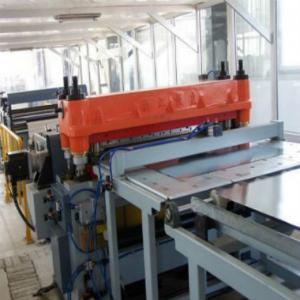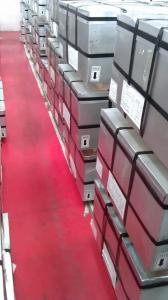Printing Tinplate Coils With Prime Quality for 0.21mm
- Loading Port:
- Tianjin
- Payment Terms:
- TT OR LC
- Min Order Qty:
- 25 m.t.
- Supply Capability:
- 1000 m.t./month
OKorder Service Pledge
OKorder Financial Service
You Might Also Like
Printing Tinplate Coils With Prime Quality for 0.21mm
1.Structure of Description
Printing Tinplate Coils With Prime Quality for 0.21mm is one of the metal packing materials, which is widely used for making painting cans ,chemical package cans , electrical cable ,battery and metal printing etc.
2. Main Features
Steady and high quality
Fast shipment
Good experience for export work
Price competitive
3. Images

4. Specification
Standard : GB2520-2000 ,JIS G3303
Steel type : SPCC
Coating : 2.8/2.8
Surface: Bright, Stone ,
Thickness:0.19
Width :600MM~1000MM
Temper : T1~T5
Package: tinplate wrapped completely with an inner cover of plastic or waterproof papers with vorners protected with metal angels.
5.FAQ
A. What is the package of tinplate? (Referred as below)
For sheets, thin plastic film + rust-proof paper + metallic cover + metallic angles+ steel band strips + fumigated wooden pallet.
For coil, thin plastic film + rust proof paper + metallic cover + steel band strips + fumigated wooden pallet
B. The surface of tinplate could you supply?
Stone finish, Bright finish, Matte finish, Silver finish
C. What quantity is the minimum order of tinplate?
Usually, the minimum quantity is 25MT. For special case, consult with us.
- Q: Can tinplate be painted or coated with other materials?
- Yes, tinplate can be painted or coated with other materials.
- Q: Can tinplate be used for renewable energy applications?
- Yes, tinplate can be used for renewable energy applications. Tinplate, which is a thin sheet of steel coated with a layer of tin, offers several advantages that make it suitable for renewable energy applications. It is highly resistant to corrosion, which is crucial for components exposed to harsh environmental conditions. Tinplate also provides excellent electrical conductivity, making it suitable for various renewable energy technologies such as solar panels and wind turbines. Additionally, tinplate is recyclable, allowing for the sustainable use of materials in the renewable energy sector.
- Q: Can tinplate be used for packaging wine or spirits?
- Yes, tinplate can be used for packaging wine or spirits. Tinplate is a type of steel coated with tin, which provides excellent protection against corrosion and can preserve the quality and flavor of the wine or spirits. Additionally, tinplate is lightweight and easy to shape, making it a suitable choice for packaging various alcoholic beverages.
- Q: Can tinplate be used for packaging confectionery products?
- Yes, tinplate can be used for packaging confectionery products. Tinplate is a popular choice due to its durability, ability to retain the quality and freshness of the confectionery, and its resistance to corrosion. It also provides a visually appealing and customizable packaging option for confectionery products.
- Q: What are the main challenges in tinplate recycling?
- The main challenges in tinplate recycling include the separation of tinplate from other materials, as well as the need for specialized recycling facilities and processes. Additionally, the collection and sorting of tinplate waste can be challenging due to its diverse sources and varied forms, such as cans, containers, and packaging.
- Q: Can tinplate packaging be used for cosmetic products?
- Yes, tinplate packaging can be used for cosmetic products. Tinplate is a durable and versatile material that provides excellent protection for cosmetic products against external factors such as moisture, light, and air. It also offers a visually appealing and premium look for cosmetic packaging. Additionally, tinplate is recyclable, making it an environmentally-friendly choice for cosmetic brands.
- Q: What are the different ways to seal tinplate cans?
- There are several different ways to seal tinplate cans. Some common methods include double seam sealing, soldering, welding, and adhesive bonding. Each method has its own advantages and suitability based on factors like the type of product being stored, the desired level of sealing integrity, and the production process.
- Q: Can tinplate be used for jewelry and fashion accessories?
- Yes, tinplate can be used for jewelry and fashion accessories. It is a versatile material that can be shaped and designed into various forms, making it suitable for creating unique and intricate jewelry pieces. Tinplate is also durable and lightweight, making it comfortable to wear. Additionally, it can be coated with different finishes or colors to enhance its aesthetic appeal.
- Q: Can tinplate be used for tobacco packaging?
- Yes, tinplate can be used for tobacco packaging. It is a commonly used material due to its durability, ability to preserve the product's freshness, and its ability to protect against moisture and external factors. Additionally, tinplate can be easily decorated and customized to create attractive packaging designs for tobacco products.
- Q: What are the common industry standards for tinplate?
- The common industry standards for tinplate include specifications for the tin coating weight, the base metal thickness, surface finish, and the adhesion of the tin coating. These standards ensure consistency and quality in the production of tinplate, allowing for its effective use in various industries such as packaging, automotive, and construction.
Send your message to us
Printing Tinplate Coils With Prime Quality for 0.21mm
- Loading Port:
- Tianjin
- Payment Terms:
- TT OR LC
- Min Order Qty:
- 25 m.t.
- Supply Capability:
- 1000 m.t./month
OKorder Service Pledge
OKorder Financial Service
Similar products
Hot products
Hot Searches
Related keywords






























